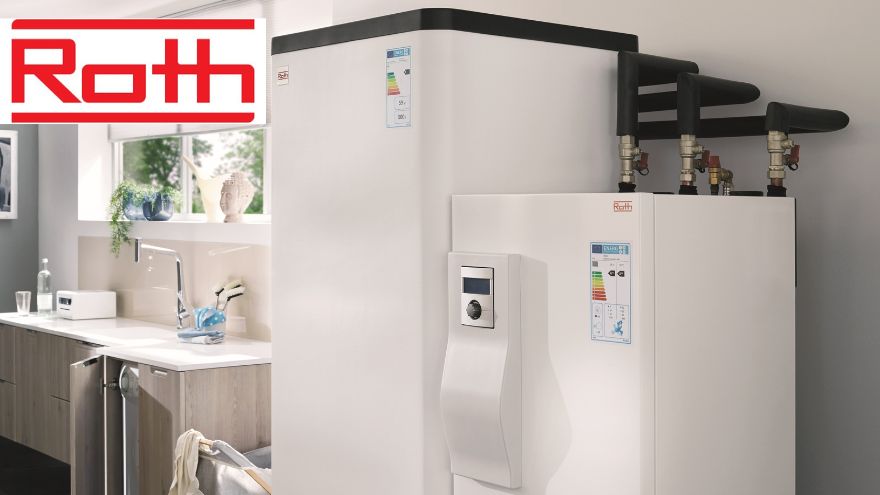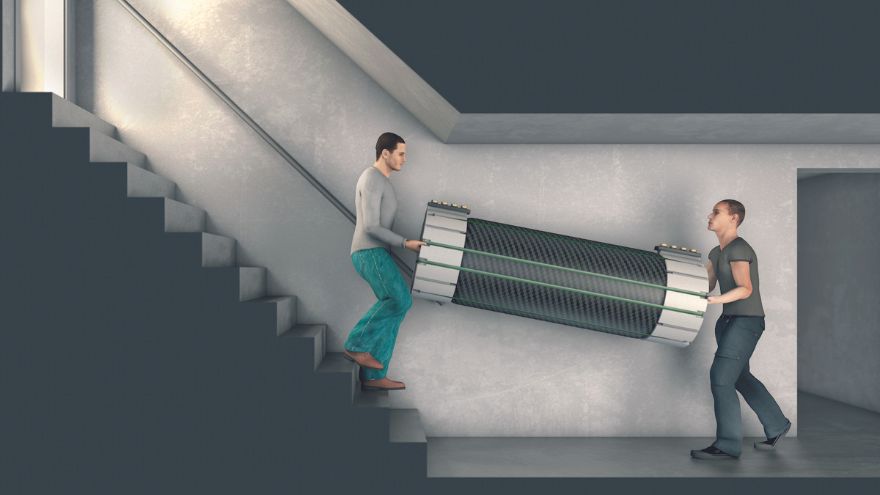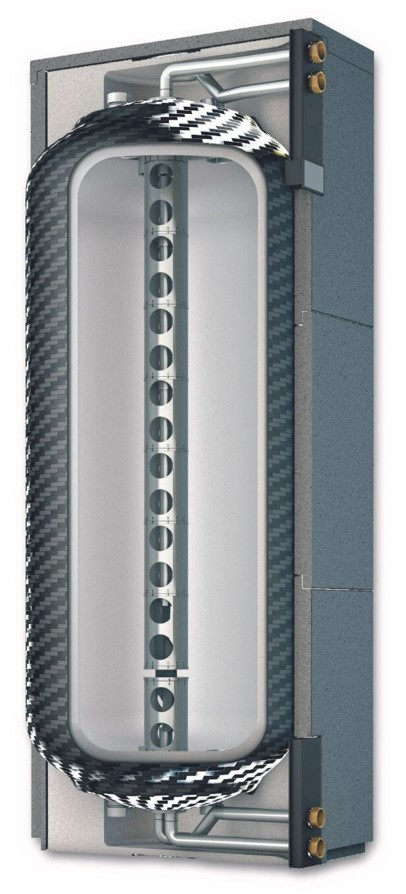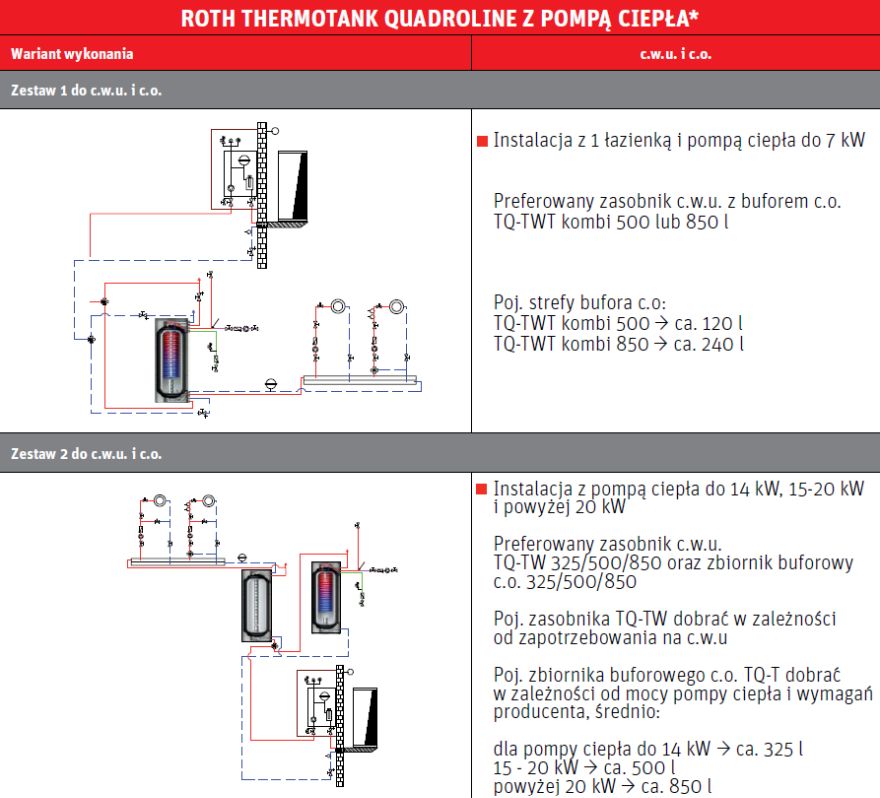We are observing a real boom in heat pumps on the installation market. Gas prices and concerns about its availability force people to look for alternative heating devices powered by energy from other sources. The costs of purchasing a heat pump are still not the lowest, but these devices pay for themselves over time through cheap operation and are maintenance-free. However, the efficiency of the heat pump also depends on refined, properly selected installation components. The buffer tank plays a special role in its proper operation.

This article will explain to you:
- the difference between a hot water tank and a buffer tank;
- the role of each of them in the heat pump heating system;
- ways of connecting buffer tanks and the advantages of each of them.
Special features Roth Thermotank Quadroline for heat pump
Roth's production experience dates back to the 1970s. In 1971, the production of polyethylene fuel oil tanks was launched, based on blow-extrusion technology. The process of producing polyethylene products, perfected for over 50 years, is still used today. The machinery park, supported by modern controls, and the extensive experience of the engineering staff made it possible to overcome a barrier that for a long time seemed insurmountable - the steel structure of the tanks was replaced by plastics .
The material used to produce Roth Thermotank Quadroline tanks for heat pumps is a composite of HDPE (PE-RT), an aluminum anti-diffusion layer and glass fiber . 100% resistance to diffusion thanks to the protective aluminum coating is confirmed by the certificate of the German Institute Fraunhofer IKTS Hermsdorf.
Roth Thermotank Quadroline tanks are available in three capacities: 325, 500 and 850 l, as buffer tanks for central heating (TQ-P), buffer tanks with a hydraulic coupling (TQ-T), coil tanks for domestic hot water (TQ- TW), coil for hot utility water with a combi buffer (TQ-TWK and TQ-TWT) and solar (TQ-S, TQ-TWS, TQ-K). The tanks are resistant to constant pressure of 3 bar and a maximum short-term operating temperature of 90° C and long-term temperature of 80° C.
 The body of the Roth Thermotank Quadroline is covered with insulating segments made of EPS, creating a square profile of the structure, allowing for optimal use of every square centimeter of surface. The compact, practical shape of the tanks, with a weight of only about 1/3 of a comparable conventional steel tank , reduces the amount of space needed in the room to a minimum. The energy efficiency class of Roth buffer tanks and hot water tanks, depending on the Thermocoat plus or Thermocoat thermal jacket used, is at level A or B, respectively.
The body of the Roth Thermotank Quadroline is covered with insulating segments made of EPS, creating a square profile of the structure, allowing for optimal use of every square centimeter of surface. The compact, practical shape of the tanks, with a weight of only about 1/3 of a comparable conventional steel tank , reduces the amount of space needed in the room to a minimum. The energy efficiency class of Roth buffer tanks and hot water tanks, depending on the Thermocoat plus or Thermocoat thermal jacket used, is at level A or B, respectively.
The role of the buffer tank in a heat pump system
The heat pump compressor is a critical and delicate component. It reacts negatively to frequent switching on and off, and its service life depends on a properly designed and constructed installation system. In the start cycle, the heat pump needs about 5 minutes to self-regulate, and it also consumes a lot of electricity. Optimizing the operation of a heat pump depends on two factors: minimum flow and minimum water load (minimum installation volume). The minimum flow is specified in the manufacturer's documentation.
Therefore, the heat pump should have a minimum operating time at nominal power and should be started less frequently, but this does not mean that it should work 24 hours a day without interruption. If heat from the pump is not transferred to the heating system within this required minimum time, high pressure faults will occur. The minimum required volume of water in the distribution pipes depends on the maximum heating power of the heat pump. If the volume of water in the heating circuit is not sufficient to ensure the minimum flow for the intended minimum operating time, central heating buffer tanks are used . Buffers limit the heat pump's on and off cycles.
The offer of Roth Quadroline buffer tanks for heat pumps includes two types: central heating buffer tank , Roth Quadroline TQ-P buffer tank for series connection and central heating buffer tank with hydraulic coupling , Roth Quadroline TQ-T buffer tank for parallel connection.
Check out the offer of tanks and containers at the Onninen wholesaler
 Serial connection of buffer tanks (equivalent to Roth Quadroline TQ-P with two connections: supply and return of the heat source/heat pump) is, on the one hand, more advantageous (in terms of energy, due to the low temperature of the tank), but on the other hand, it is hydraulically demanding - it should be install a bypass with a differential pressure relief valve to ensure minimum flow for the heat pump when one or more underfloor heating loops equipped with manifold valve actuators are closed. Systems of serial buffer tanks are recommended only in installations with one heating circuit and in systems with a maximum of one circulation pump , and are used to increase the volume of the heating system.
Serial connection of buffer tanks (equivalent to Roth Quadroline TQ-P with two connections: supply and return of the heat source/heat pump) is, on the one hand, more advantageous (in terms of energy, due to the low temperature of the tank), but on the other hand, it is hydraulically demanding - it should be install a bypass with a differential pressure relief valve to ensure minimum flow for the heat pump when one or more underfloor heating loops equipped with manifold valve actuators are closed. Systems of serial buffer tanks are recommended only in installations with one heating circuit and in systems with a maximum of one circulation pump , and are used to increase the volume of the heating system.
Additionally, we can distinguish supply and return buffer tanks . The advantage of including the buffer tank in the power supply circuit is the possibility of integrating it with a heater as an additional heat source. Locating the tank in the return circuit reduces heat losses, but does not allow for additional heating of the tank . Return buffer tanks are used to increase the volume of the installation and extend the operating time of the heat pump compressor.
Buffer tanks connected in parallel (equivalent to Roth Quadroline TQ-T
with four connections: supply and return from the heat source/heat pump and supply and return from the installation, e.g. underfloor heating) separate the heat source (pump) from the heating circuit, thus fulfilling the function of a hydraulic coupling . Hydraulic decoupling is always necessary when connecting several heating circuits, including those operating at different flow rates and with min. two circulation pumps (one pump feeds from the heat pump to the tank, the other to underfloor or underfloor heating and radiators). This connection is the surest way to avoid plumbing errors. Parallel operation of the tank ensures the necessary minimum flow for the heat pump.
Buffer tanks ensure proper operation of the heat pump
- maintain the required minimum water flow through the heat pump condenser when underfloor heating loops are equipped with distributor valve actuators that may limit the flow of heating water,
- guarantee the required minimum water charge for proper operation of the heat pump unit,
- act as a hydraulic coupling in an installation with an additional heat source , e.g. a gas boiler (connecting existing heat sources) or in a mixed installation of underfloor and radiator heating, operating at different flow rates,
- they store heat to perform the defrosting function of the periodically frosted evaporator of an air-to-water heat pump during the heating season at an external temperature ≤0° C (when heat is drawn from the environment in winter, moisture condenses, which freezes and limits the flow; the heat pump starts defrosting to defrost the evaporator; the heat needed for this process is taken from the buffer).
Roth Thermotank Quadroline for preparing domestic hot water
A characteristic feature of Roth Thermotank Quadroline hot water tanks is the hygienic, "clean" way of operation. Hot utility water is located only in a stainless steel coil with a length of 26 m for 325 and 500 l tanks and 38 m for a tank with a capacity of 850 l. The water in the coil for utility purposes is heated by the water in the remaining part of the tank (on a flow basis) and only in the amount needed, which eliminates water downtime and the creation of an environment conducive to the development of microorganisms.
There are three variants of the Roth Thermotank Quadroline for hot water to choose from: the Roth TQ-TW 325/500/850 hot water tank with a coil , the Roth TQ-TWK combi 500/850 hot water tank with a coil and central heating buffer, and the Roth TQ-TWT combi 500 hot water tank. /850 with coil and central heating buffer with hydraulic clutch .
The capacity of the hot water tank in combination with a heat pump should be selected depending on the demand for domestic hot water. The capacity of the hot water tank does not depend on the power of the heat pump.
